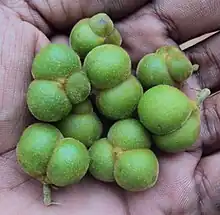| Sapindus trifoliatus | |
|---|---|
 | |
| Berries in hand | |
_(3092506869).jpg.webp) | |
| Younger specimens | |
| Scientific classification | |
| Kingdom: | Plantae |
| Clade: | Tracheophytes |
| Clade: | Angiosperms |
| Clade: | Eudicots |
| Clade: | Rosids |
| Order: | Sapindales |
| Family: | Sapindaceae |
| Genus: | Sapindus |
| Species: | S. trifoliatus |
| Binomial name | |
| Sapindus trifoliatus | |
| Synonyms[1] | |
| |
Sapindus trifoliatus, the South India soapnut or three-leaf soapberry, is a species of flowering plant in the family Sapindaceae, native to Pakistan, India, Bangladesh, the Andaman Islands, Myanmar, and Sri Lanka, and introduced to eastern tropical Africa, Rodrigues, and Trinidad and Tobago.[1][2] An evergreen tree reaching 25 m (82 ft), its seeds are rich in saponins, and are both collected in the wild and cultivated to make soap for washing fabrics.[3]
References
- 1 2 "Sapindus trifoliatus L." Plants of the World Online. Royal Botanic Gardens, Kew. Retrieved 28 October 2022.
- ↑ "South India Soapnut". Flowers of India. 2022. Retrieved 28 October 2022.
- ↑ Fern, Ken (20 July 2022). "Useful Tropical Plants Sapindus trifoliatus L. Sapindaceae". tropical.theferns.info. Tropical Plants Database. Retrieved 28 October 2022.
This article is issued from Wikipedia. The text is licensed under Creative Commons - Attribution - Sharealike. Additional terms may apply for the media files.